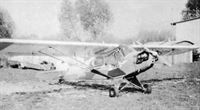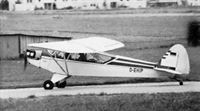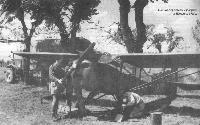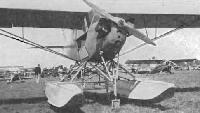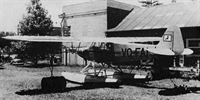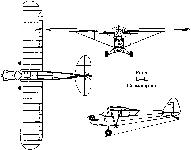
Варианты
- Taylor - Cub - 1931 - США
- Piper - Cub J-3/J-4 / L-4 Grasshopper / PA-11 - 1937 - США
- Piper - Cruiser J-5 / L-14 / PA-12 / PA-14 - 1939 - США
- CNNA - HL-1 - 1940 - Бразилия
- Piper - TG-8 - 1941 - США
- CAP (Paulista) - CAP-4 Paulistinha - 1945 - Бразилия
- Piper - Super Cub PA-18 / L-8 / L-21 - 1949 - США
- Miller - Twin / M-6 - 1957 - Великобритания
- LIPNUR - NU-85 Belalang / NU-90 - 1958 - Индонезия
- Datwyler - MDC-Trailer - 1962 - Швейцария
- Wag-Aero - CUBy / Wag-A-Bond - 1975 - США
- CubCrafters - Carbon Cub EX / XCub - 2008 - США
J-3/J-4 Cub / L-4 Grasshopper / PA-11
Самолет связи и корректировщик. Одномоторный подкосный моноплан с верхним расположением крыла и неубирающимся шасси. Военный вариант массового легкомоторного самолета J-3 "Каб". "Каб", также как английский Тэйлоркрафт D, являлся модернизацией Е-2, сконструированного Г. Тэйлором из "Тэйлор эйркрафт корпорейшн". "Тэйлор эйркрафт", сменив владельца, превратилась в "Пайпер эйркрафт", где группа конструкторов под руководством У. Жамонэ усовершенствовала машину. С 1931 г. J-3 строился серийно заводом "Пайпер" в Лок-Хэвене.
Летом 1941 г. на войсковые испытания передали военный вариант J-3 - ближний разведчик-корректировщик YO-59. После их успешного прохождения развернули серийное производство самолетов для ВВС армии США. Всего по военным заказам изготовлено 5548 экз. C 1942 г. O-59 переименовали в L-59, позднее -в L-4.
Двигатель A-65-8 (на L-4, L-4A, L-4B), O-235-5 (на L-4F, L-4G, L-4H, L-4J). Экипаж самолета - 2-3 чел. Вооружения нет.
Основные серийные военные модификации:
- O-59 (L-59, L-4) с мотором A-65-8, экипаж - 2 чел.;
- O-59A (L-4A) с измененным остеклением кабины;
- L-4B с измененным радиооборудованием;
- L-4F на базе J-5A с мотором O-235-5, экипаж - 3 чел.;
- L-4G на базе J-5B с мотором O-235-5, экипаж - 3 чел.;
- L-4H, вариант модификации G с измененным оборудованием;
- L-4J с винтом изменяемого шага.
В годы Второй мировой войны "Грассхоппер" состоял на вооружении в США с конца 1941 г., во Франции - с 1943 г., в Бразилии - с 1944 г. С декабря 1941 г. американские O-59 принимали участие в патрулировании побережья США. С сентября 1942 г. они были размещены в Великобритании как самолеты связи. В ноябре 1942 г. L-4 взлетали с кораблей во время высадки десанта в Северной Африке. Позднее эти машины использовались как корректировщики, санитарные и связные самолеты в Тунисе, на Сицилии, в Италии, в Бирме и Китае. С июня 1944 г., после вторжения в Нормандию, самолеты этого типа активно применялись в Европе. Военные варианты "Каба" прекратили выпускать в 1945 г., гражданские - в 1950 г.
L-4 сняли с вооружения в США в ноябре 1947 г.
L-4||
Размах:||10,67 м
Длина:||6,7 м
Моторы, количество х мощность:||1 x 65 л.с.
Взлетная масса, максимальная:||555 кг
Максимальная скорость:||136 км/ч
Практический потолок:||2830 м
Дальность:||305 км
Описание:
- J-3/J-4 Cub / L-4 Grasshopper / PA-11
- Piper J-3 Cub, O-59, L-4 Grasshopper и J-4 Cub Coupe
- Piper PA-11 Cub Special
- Flight, March 1939
STANDARD - WITH differences - Flight, September 1939
To-day's Light Aeroplanes
Фотографии
-
Мировая Авиация 214
Первое обозначение военных Cub было O-59, но затем самолет переклассифицировали в связные, обозначив L-4, а с 1942 года - как наблюдательный самолет. Многие самолеты летают и сегодня.
-
АвиаМастер 2003-03 / М.Жирохов, А.Котлобовский - Небесные войны Индонезии /Горячая точка/ (2)
Пайпер "Кэб", состоявший на вооружении ВВС Индонезии в 1950-х годах.
-
Air Enthusiast 1999-03 / R.Neto - 'Ugly Ducklings' and the 'Forgotten Division' (1)
Piper L-4H Grasshopper ‘5’ of the la Esquadrilha de Ligacao e Observacao (1st Brazilian Liaison Squadron). Note whip aerial. Scrapview shows USAAF star-n-bar under the starboard wing.
-
Aeroplane Monthly 1994-04 / H.Levy - Flitfire
Регистрационный номер: NC1776 [5] Flitfire in pristine condition after its 18-month, 800hr rebuild at the skilled hands of Dave Henderson.
-
Aeroplane Monthly 1994-04 / H.Levy - Flitfire
Регистрационный номер: NC1776 [5] -
Aeroplane Monthly 1994-04 / H.Levy - Flitfire
Регистрационный номер: NC1776 [5] This Cub has a 65 h.p. Franklin, but the others used in the fund drive had Lycomings.
-
Aeroplane Monthly 1994-04 / H.Levy - Flitfire
Регистрационный номер: NC1776 [5] The “Royal Air Force Benevolent Fund” legend on the rear fuselage proudly proclaimed the Cub’s charitable intentions in the early 1940s. The lucky winner of NC1776 donated it to the Civilian Pilot Training Program sponsored by the US Government.
-
Мировая Авиация 196
Маневренный, устойчивый и простой в пилотировании Piper Cub стал первым полноценным самолетом для массового рынка. Выпуск машин семейства Cub/Super Cub продолжался до ноября 1982 года.
-
Air Enthusiast 2006-01 / G.Jones - George's 'Canary' /History on the wing/
The N3N in formation with a neighbour at Auburn - Andy Weinberg's Piper J3.
Другие самолёты на фотографии: Naval Aircraft Factory N3N Canary - США - 1935
-
Aeroplane Monthly 1983-02
Регистрационный номер: HB-ELI Piper J3C Cub HB-ELI photographed in Switzerland in October 1982 by E. GANDET
-
Air International 1991-06 / G.Jones - Crossair: Mature Teenager
Регистрационный номер: HB-OIC One of the two Piper J3C Cubs photographed at a PFA rally in 1979 and registered to Business Flyers Basel AG, the company started by Crossair President Moritz Suter in February 1975. The other aircraft was HB-OBP.
-
Aeroplane Monthly 1994-04 / H.Levy - Flitfire
Регистрационный номер: N11190 Another of Dave Henderson's meticulous restorations was this Piper L-4B, N11190/43507.
-
Aeroplane Monthly 1999-10 / P.Franzini - A Late Renaissance /Italy's warbird scene/ (1)
One of the most popular warbirds in Italy, a Piper J-3 Cub, part of the Jonathan Collection fleet at Nervesa della Battaglia, the new home of this famous collection.
-
Aviation Historian 32 / J.-C.Carbonel - France's Air Pioneers: Louis Bleriot
Регистрационный номер: N50364 Although many of Bleriot’s aeronautical patent applications were wishful thinking at best, the cable-and-hook system did ultimately prove practicable and was used operationally on ships during the Second World War, although whether Bleriot’s patent was an influence is unknown. This Piper L-4, N50364/43-1439, based at Anoka, Minneapolis, is fitted with the hook used with the Brodie shipborne cable-and-hook system.
-
Aeroplane Monthly 1996-04 / M.Oakey - Vintage news
Регистрационный номер: G-BBLH [2] Piper J3C-65 Cub G-BBLH has recently been restored in the markings of an L-4 of the US Army’s 183rd Field Battalion, based in Germany in 1945. Built in 1943, ’LH is believed to have seen American service in North Africa before embarking on its postwar civil career. Owned jointly by Mike Dunkerly and Peter Greenyer, the Biggin-based Cub made its C of A test flight on January 31, 1995.
-
Мировая Авиация 214
Регистрационный номер: CF-CUB Самолет с регистрационным номером CF-CUB - модель PA-11 Cub Special образца 1947 года. Он был первым в семействе Cub с полностью закрытым двигателем.
-
Aeroplane Monthly 1998-12 / M.Vines - Rhinebeck revisites /Circus flying/
Stanley Segalla, the “Flying Farmer” makes one of his frightening one-wheel landings during his masterly crazy-flying performance. This is one of the most popular items with the spectators.
-
Aeroplane Monthly 1991-07 / M.Vines - Sun'n'Fun'n'Floats
A Piper J-3 Cub.
-
Мировая Авиация 8
Регистрационный номер: C-FOLM Самолеты типа Aeronca и Piper Cub (фото) в последние годы стали использовать в труднодоступных регионах, несмотря на очевидный недостаток удельной мощности этих машин (особенно ярко недобор мощности проявляется в вариантах с поплавковым шасси) и малую грузоподъемность.
-
Jane's All the World Aircraft 1938 / 03 - All the world's aeroplanes
Регистрационный номер: NC20852 The Piper "Cub" Two-seat Light Cabin Monoplane (40 h.p. Continental A-40 engine).
-
Мировая Авиация 196
Регистрационный номер: NC30440 Развитием J-3 стал J-4 Cub Coupe с полностью закрытым двигателем и шасси с обтекателями и тормозами. Самолеты хорошо продавались в США, и в годы войны некоторые из них использовались военными.
The Piper J4 Coupe Two-seat Light Cabin Monoplane (75 h.p. Continental engine). -
Мировая Авиация 196
Регистрационный номер: NX33527 J-3 Cub раннего выпуска демонстрирует элегантные обводы, присущие машинам семейства Piper Cub. На J-3 было установлено увеличенное вертикальное оперение и хвостовое колесо.
-
Aeroplane Monthly 1980-11 / H.Levy - Oshkosh'80
Back to basics, a Piper Cub about to land on the back of a travelling truck.
-
Aeroplane Monthly 1983-11 / S.Piercey - Oshkosh antics
Crazy Flying Piper Cub
-
Jane's All the World Aircraft 1980 / Encyclopedia of Aviation - Aircraft A-Z - v5
Регистрационный номер: N30348 Piper J-4 Cub Coupe.
-
Air-Britain Archive 1980-01
Регистрационный номер: N58371 8910 N58371 erected at Frankfurt 9.8.5 6 only nine days after arrival from the USA.
-
Air-Britain Archive 1980-02
Регистрационный номер: N9829F [2], D-EGZG [2] The ex-British Cub N9829F in Frankfurt Flyers Association colours at Reichelsheim 13.2.67.
-
Air Pictorial 1958-10
Регистрационный номер: N9830F, G-AIYV The yellow Piper Cub N9830F was repainted at Fairoaks ex G-AIYV with the licence number properly belonging to the Constellation which was once G-ANUV.
-
Flight 1939-03 / Flight
Despite the useful cabin width and the fact that it is a braced high-wing machine, this frontal view shows that the Cub Coupe has comparatively clean lines. The photographer escaped with his life.
-
Aeroplane Monthly 1983-02 / L.Curtis - Flying for all
Регистрационный номер: G-AFPP [2] This side by side, two seat Piper Cub Coupe is seen flying at Hanworth in 1939 and was the first of 24 to be imported to Britain from the USA. Many were used on Civil Air Guard flying.
-
Flight 1939-09 / Flight
Регистрационный номер: G-AFPP [2] The Piper Cub is now being produced in 65 h.p. form. This is the 50 h.p. Coupe.
-
Air Pictorial 1987-09 / A.Johnson - Register Review
Регистрационный номер: G-AFZA Piper J/4A Cub Coupe G-AFZA, one of three currently registered in the UK, was a visitor to the Air-Britain Air Rally.
-
Aeroplane Monthly 1981-09 / ??? - PFA at Leicester
Регистрационный номер: G-AIIH The veteran Piper L-4H Cub G-AIIH.
-
Air-Britain Archive 1980-02
Регистрационный номер: G-AJDS, D-EJYD Still wearing its British marks G-AJDS although D-EJYD had already been allocated, c/n 11658 was photographed at Dusseldorf on 4.10.58.
-
Air-Britain Archive 1988-01
Регистрационный номер: G-AKAA Sedate fly-past from the still very active Cub G-AKAA at Badminton Air Day on 15.7.84.
-
Jane's All the World Aircraft 1980 / Encyclopedia of Aviation - Aircraft A-Z - v5
Регистрационный номер: G-ASPS Piper J-3C-65 Cub.
-
Air Pictorial 1992-03
Регистрационный номер: G-BLPA Another vintage machine at Finmere was Piper J-3C-65 G-BLPA, one of the residents which joined in the fun.
-
Air-Britain Archive 1984-02
Регистрационный номер: CX-AEV CX-AEV We now have this photo, via Gary Kuhn, but are no nearer tracing its true identity.
-
Air-Britain Archive 1980-03
Регистрационный номер: D-EBIS D-EBIS (12513) with LSV Schwarzwald at Winzeln, 25.8.73
-
Air-Britain Archive 1980-03
Регистрационный номер: D-EBIW The Datwyler rebuild D-EBIW (12874) at Gelnhausen on 3.10.71
-
Air-Britain Archive 1980-03
Регистрационный номер: D-EBOR Prominent Burda titles on D-EBOR (12933) at Egelsbach, 3.7.58
-
Air-Britain Archive 1981-01
Регистрационный номер: D-EBYR One of the ex-Norwegian Cubs with an incorrectly quoted identity, D-EBYR (12911) outside the Roder Prazision premises at Egelsbach on 16.6.59.
-
Air-Britain Archive 1980-01
Регистрационный номер: D-ECIZ 8391 D-ECIZ at Northeim, its last base in Germany before sale to Denmark.
-
Air-Britain Archive 1980-04
Регистрационный номер: D-EDAP D-EDAP (22617) at Braunschweig 30.10.70, is another German Cub still flying in Denmark
-
Air-Britain Archive 1980-04
Регистрационный номер: D-EDYR D-EDYR (c/n 13384) landing at Egelsbach 1.6.58 during a period when it was based there with Motorflug GmbH.
-
Air-Britain Archive 1980-03
Регистрационный номер: D-EFBP [2], LX-ABO [2] D-EFBP (c/n 12847) never received a German permit or C of A but was used as an advertising display in Essen-Grugapark during April 1975.
-
Air-Britain Archive 1980-01
Регистрационный номер: D-EFER 10793 D-EFER seen wingless at Bonn-Hangelar 10.5.73 was sold to Norway but remains inactive.
-
Air-Britain Archive 1980-02
Регистрационный номер: D-EGIS D-EGIS (11030) a t Karlsruhe 11.4.76 , its last base before sale to Austria.
-
Air-Britain Archive 1980-01
Регистрационный номер: D-EGOV 10263 D-EGOV carrying the Roder Prazision titles of its 1960s owner Wilhelm Roder of Egelsbach.
-
Air-Britain Archive 1980-04
Регистрационный номер: D-EGOZ D-EGOZ (23175) seen at Dortmund 23.3.72 was later damaged and is now undergoing restoration in Denmark.
-
Air-Britain Archive 1980-02
Регистрационный номер: D-EGZG [2], N9829F [2] The ex-British Cub N9829F in its present guise as D-EGZG (11295) at Hopsten Air Base, 11.6.77.
-
Air-Britain Archive 1980-04
Регистрационный номер: D-EHIP D-EHIP (19092) was a visitor to Herzogenaurach on 17.9.77.
-
Air-Britain Archive 1980-04
Регистрационный номер: D-EJIQ [2], OH-PCZ [2] D-EJIQ (15733) at Egelsbach 15.8.70, its final German base before sale to Finland.
-
Air-Britain Archive 1980-02
Регистрационный номер: D-EJIX The second ex-Czech Cub D-EJIX whose documents became interchanged with those of D-EJAX as recounted above and which is illustrated at the beginning of this episode. (P.M.Gerhardt at Schwabach 10.9.78)
-
Air-Britain Archive 1980-01
Регистрационный номер: D-EJUM The oldest Cub to be registered in West Germany, D-EJUM is still active over forty years after being built.
-
Air-Britain Archive 1980-03
Регистрационный номер: D-EKEG D-EKEG (12512) taken at an unidentified location
-
Air-Britain Archive 1980-01
Регистрационный номер: D-ELLY 8622 D-ELLY seen here at Vogtareuth 22.10.76, was built from parts by AeC Saar in 1960.
-
Air-Britain Archive 1980-01
Регистрационный номер: D-ELUM 11005 D-ELUM wearing a 'Coburg' insignia at Herzogenaurach 13.5.74.
-
Air-Britain Archive 1980-04
Регистрационный номер: D-ENUL Built as a civil Cub post-war, D-ENUL (23165) was converted to J3C-90 in Germany and is seen here at its Michelstadt base with fully-cowled engine on 26.3.67.
-
Air Pictorial 1977-10
Регистрационный номер: EI-BCM Newly registered in Ireland: The Kilmoon Flying Club’s ex-French J3C-65 Cub EI-BCM at Castlebridge 10/7/77;
-
Aeroplane Monthly 1974-04 / B.Martin - Britain's civil aircraft register
Регистрационный номер: F-BBSQ, G-BBUU Jennifer Pothecary’s Piper Cub, G-BBUU, photographed at Sywell last year in its French markings.
-
Air Pictorial 1956-07 / Air Pictorial's photo-review
Регистрационный номер: HB-ODW SWISS-MODIFIED CUB HB-ODW is a Model J3C-65 Cub Special (c/n. 12542, ex-U.S.A.A.F. 44-80246), tandem seater, powered by a 65-h.p. Continental A-65. Novelty: reviseal rear-vision canopy, slimmer rear fuselage and curved-fillet fin.
-
Air-Britain Archive 1981-01
Регистрационный номер: LX-ABO [2], D-EFBP [2] LX-ABO was allocated D-EFBP 7.73 but ntu although displayed statically as such
-
Air-Britain Archive 1981-01
Регистрационный номер: OH-PCZ [2], D-EJIQ [2] After a lengthy civil career in USA and Germany, D-EJIQ became OH-PCZ and is seen here at Jyvaskyla, Finland on 22.6.74 before being officially registered 4.75.
-
Air-Britain Archive 1980-02
Регистрационный номер: OK-ANO, D-EJAX Czechoslovakian Cubs are not frequently to be seen in print so we lead this section with OK-ANO at Egelsbach on 1.6.58 shortly after its arrival for overhaul and registration as D-EJAX. C/n is 12261.
-
Air-Britain Archive 1980-03
Регистрационный номер: OO-AAO Piper Cubs were the first and most numerous trainers available to Belgian clubs after the war. OO-AAO (536) in Royal Motor Union colours at Liege.
-
Air-Britain Archive 1980-03
Регистрационный номер: OO-AAT Piper Cubs were the first and most numerous trainers available to Belgian clubs after the war. OO-AAT (524) which suffered a complicated exchange of fuselages in the 60s.
-
Air-Britain Archive 1981-04
Регистрационный номер: OO-ACB [2], OO-GEL [2] Formerly the first OO-GEL, Cub OO-ACB in Ecole Devleminck titles at Grimbergen.
-
Air-Britain Archive 1981-04
Регистрационный номер: OO-AFI OO-AFI (1237) another of the Devleminck flying school Cubs. This one became unairworthy in 1970 but the actual reason for cancellation is not known to us.
-
Air-Britain Archive 1982-02
Регистрационный номер: OO-AVX Cub OO-AVX (624) which was cancelled in 1970 was still in existence at Grimbergen as recently as 14.10.78.
-
Air-Britain Archive 1985-04
Регистрационный номер: OO-COR Piper Cub OO-COR (2844) at Schaffen 11.8.84.
-
Air-Britain Archive 1980-03
Регистрационный номер: OO-GAA Piper Cubs were the first and most numerous trainers available to Belgian clubs after the war. Ghent Aviation Club badges and registration series worn by OO-GAA (500) visiting Southend in 1947.
-
Air-Britain Archive 1981-01
Регистрационный номер: OO-GEL [2], OO-ACB [2] Piper L-4J Cub OO-GEL,whose identity is still a source of some confusion, at Liege in Royal Motor Union colours.
-
Air-Britain Archive 1987-04
Регистрационный номер: OO-GMS The all-yellow ex-Dutch J3C Cub OO-GMS (3460) at Namur-Temploux in late 1985.
-
Air-Britain Archive 1983-02
Регистрационный номер: OO-JOZ [3], PH-NKC [3], PH-UCH [3] Piper J-3C-65 Cub with a very complex history is OO-JOZ (1867) formerly PH-NKC.
-
Air-Britain Archive 1981-01
Регистрационный номер: OY-DHC, D-EBER Formerly D-EBER, OY-DHC was a Sywell '76 visitor.
-
Aeroplane Monthly 1980-09 / News Spotlight
Регистрационный номер: OY-ECT Danish Piper J-3C-85 Cub OY-ECT from Ry.
-
Aeroplane Monthly 1979-05
Регистрационный номер: OY-ECV A quartet of ski-equipped, Danish-registered Piper Cubs, photographed recently by Torkild Balslev.
Другие самолёты на фотографии: Piper Super Cub PA-18 / L-8 / L-21 - США - 1949
-
Aeroplane Monthly 2000-04 / M.Hooks - Gatwick arrivals /Post-war rally/
Регистрационный номер: PH-NCU A line-up of visiting aircraft at the Gatwick rally. Piper Cub PH-NCU was unfortuinately involved in a fatal crash on its return flight. In the background a number of Spitfires await attention from Airwork, in front of three Saudi Lodestars.
Другие самолёты на фотографии: Lockheed Lodestar L-18/C-59/R5O - США - 1939Piper Cruiser J-5 / L-14 / PA-12 / PA-14 - США - 1939Supermarine Spitfire Mk.XVIII / 21 / 22 / 24 - Великобритания - 1944
-
Air-Britain Archive 1982-01
Регистрационный номер: PH-NCW PH-NCW (c/n 23040) while in service with NLS.
-
Air-Britain Archive 1982-01
Регистрационный номер: PH-NIL PH-NIL (10710) after being withdrawn from use and before sale to the USA
-
Air-Britain Archive 1982-01
Регистрационный номер: PH-NKC [3], OO-JOZ [3], PH-UCH [3] PH-NKC the Cub built by NLS from the fuselage of PH-UCH, probably taken at Rotterdam in the early sixties
-
Air-Britain Archive 1982-01
Регистрационный номер: PH-NLA PH-NLA (12772) at Teuge on 30.9.72 with Schreiner logo on the tail though owned by NLS
-
Air-Britain Archive 1982-01
Регистрационный номер: PH-UCE [3], N70282 [3] PH-UCE (18546) built as a J3C-65 and now current in the USA as N70282.
-
Air-Britain Archive 1982-01
Регистрационный номер: PH-UCG PH-UCG (13347) with current owner H.Maatman at the controls taxying at Teuge 11.7.81
-
Air-Britain Archive 1982-01
Регистрационный номер: PH-UCE [3], PH-UCH [3], N70282 [3], OO-JOZ [3], PH-NKC [3] Piper Cubs PH-UCH and PH-UCE of the Nationale Luchtvaartschool at Hilversum on 27.8.64. A complete survey of all Dutch-registered Cubs is featured in this issue.
-
Air-Britain Archive 1982-01
Регистрационный номер: PH-UCI PH-UCI (13351) in the early fifties at Rotterdam.
-
Air-Britain Archive 1982-01
Регистрационный номер: PH-UCN A rare shot of the short-lived PH-UCN (13366) of the Gooi-Stichtse Aeroclub.
-
Air-Britain Archive 1982-01
Регистрационный номер: PH-UCE [3], PH-UCP, N70282 [3] PH-UCP (13211) in original NLS colour scheme with PH-UCE (18546) in revised scheme behind
-
Air-Britain Archive 1982-01
Регистрационный номер: PH-UCR PH-UCR (13211) at Hoogeveen in the early sixties
-
Air-Britain Archive 1982-01
Регистрационный номер: PH-UCS PH-UCS (13228) at Hoogeveen in the early sixties
-
Air-Britain Archive 1980-02
Регистрационный номер: SL-AAK, D-ECIV SL-AAK, with brewery ownership clearly displayed , later became D-ECIV (11364) when the Saar register was incorporated into that of West Germany.
-
Air-Britain Archive 1983-01
Регистрационный номер: ZK-AHC One of the still active 1939 vintage Cubs: Piper J-3C Cub ZK-AHC in an attractive modern paint scheme at Christchurch on 10.9.78;
-
Air-Britain Archive 1983-01
Регистрационный номер: ZK-AHD One of the still active 1939 vintage Cubs: Piper J-3C Cub ZK-AHD wearing generous sized markings!
-
Jane's All the World Aircraft 1946 / 03 - All the world's aeroplanes
The Piper L-4H Grasshopper Light Observation and Liaison Monoplane (65 h.p. Continental O-170-3 engine).
-
Aeroplane Monthly 1980-03 / Personal album
The United States Army Air Force Piper Cub 666 bears shark’s teeth markings on the engine cowling and an impression of Popeye’s nephew, Swee’Pea, beneath the cockpit. The significance of the inscription “AH-OY” is not known. In the background is the hangar used by 116 Squadron and the RCAF target tug unit.
-
Aeroplane Monthly 1985-06
Регистрационный номер: G-AXHR Piper L-4H Cub 43-29601/G-AXHR photographed by KEITH WILSON/ACTION 2 PHOTOGRAPHY, during the time it was owned by David Elphik.
-
Мировая Авиация 214
L-4 Grasshopper воевал на всех ТВД, где находились американские войска. На снимке - два L-4B только что вылетели на разведку с аэродрома в джунглях где-то в Бирме.
-
Jane's All the World Aircraft 1980 / Encyclopedia of Aviation - Aircraft A-Z - v5
Piper L-4s operated in the China/Burma theatre during World War II.
-
Мировая Авиация 214
Piper L-4 Grasshopper применялся Армией США практически в каждой военной кампании и на всех фронтах Второй мировой войны.
-
Моделист-Конструктор Ближние разведчики, корректировщики и штурмовики Второй мировой войны
Регистрационный номер: G-BBLH [2] "Грассхоппер" в камуфляже ВВС армии США до наших дней летает в Великобритании
-
Авиация и Космонавтика 2024-12 / В.Хвощин - Видеть дальше "буратиньего носа" (2)
Верховный главнокомандующий экспедиционными силами союзников в Европе генерал армии Дуайт («Айк») Эйзенхауэр и его пилот майор Т. Уолкер в самолете Piper L-4 «Grasshopper» перед выполнением обзорного полета над линией фронта. Италия, приблизительно август 1943 года
-
Мировая Авиация 214
Один из самых необычных экспериментов военных - посадочная система «Brodie», разработанная для посадки машин в джунглях и горах. Самолет зацепляется гаком за нейлоновую уздечку и по тросу опускается на аэродром.
-
Моделист-Конструктор Ближние разведчики, корректировщики и штурмовики Второй мировой войны
L-4 на передовом аэродроме в Италии, 1945 г.
-
Air Enthusiast 1999-03 / R.Neto - 'Ugly Ducklings' and the 'Forgotten Division' (1)
An L-4H of the 1 ELO taking off from San Rossore in October 1944. It still carries US insignia on the fuselage.
-
Авиация и Время 2003-03 / А.Харук - ВВС Бразилии во второй мировой войне (2)
Бразильский "Пайпер" L-4H в полете
-
Air Enthusiast 1999-03 / R.Neto - 'Ugly Ducklings' and the 'Forgotten Division' (1)
L-4Hs of the 1 ELO flying over Bergamo, in July 1945. The aircraft were being ferried to be handed over to the Americans who were to ship them to Brazil.
-
Авиация и Время 2003-03 / А.Харук - ВВС Бразилии во второй мировой войне (2)
L-4H на полевом аэродроме. Италия, весна 1945г.
-
Air Enthusiast 1999-03 / R.Neto - 'Ugly Ducklings' and the 'Forgotten Division' (1)
Assembling an L-4H for the 1 ELO at San Rossore, near Pisa, October 1944.
-
Air Enthusiast 1999-03 / R.Neto - 'Ugly Ducklings' and the 'Forgotten Division' (1)
Joe Clapp, with his L-4H No.9, ‘Lilly’.
-
Air Enthusiast 1999-03 / R.Neto - 'Ugly Ducklings' and the 'Forgotten Division' (1)
A Brazilian Air Force pilot and Army observer aboard on the L-4Hs of the 1 ELO.
-
Aeroplane Monthly 1991-12 / M.Oakey - Grapevine
Syria tends to be off the beaten track for most aviation enthusiasts, but London reader Brian Murray has sent us some photographs taken recently at the Damascus Military Museum. Several aircraft, including the Harvard, the Cub shown, an Aero L-29 Delfin and a Wallis autogyro, are on outdoor display amongst trees, giving the impression, as Murray puts it, of having been "dropped vertically into their overgrown landscape". The Harvard has clearly had evergreen saplings planted right next to its fuselage after it had been positioned - presumably to provide growing protection from the Syrian sun.
-
Авиация и Время 2001-05 / М.Жирохов, Д.Шевчук - ВВС Израиля, 1948-49гг. (2)
В 1948г. колекция "примусов" ВВС Израиля пополнилась очередными "Кэбами"
-
Aviation Historian 15 / S.Aloni - The Pick-up Artist
The first of the Israeli Air Force Piper J3/L-4 Cubs, "0401”, is seen here in the background at Ramla the day after Enoch Keret flew it on the preliminary reconnaissance mission over the Sinai Peninsula on May 28, 1955. The Israelis received 20 of these early-model Cubs from August 1948, with PA-18 Super Cubs arriving from 1955.
-
Air Enthusiast 1998-11 / S.Aloni, P.Arnold - From Israel to Burma (1)
Air-to-ground of 2058, exported to Burma as UB439. Note the outline of the Auster or Cub that took the shot!
Другие самолёты на фотографии: Supermarine Spitfire Mk.IX / XVI - Великобритания - 1942
-
Авиация и Космонавтика 2018-02 / В.Морозов - Авиация Литвы: 1919-2018гг. (2)
Аэроклуб Каунаса. На переднем плане видны четыре планера разных типов (в основном германского производства), за ними самолеты Бюккер-133 и Пайпер «Кэб», 1939 г.
Другие самолёты на фотографии: Bucker Bu.133 Jungmeister - Германия - 1935Oskinis BRO-4 Ruta - Литва - 1937
-
Мировая Авиация 196
Регистрационный номер: NC26928 Варианты J-3 с поплавковым шасси получали в конце обозначения букву "S". На снимке: самолет с поплавками Edo (Edo - сокращение имени разработчика поплавков - Earl D. Osborn), окрашенный по стандартной схеме в желтый цвет с черными полосами и несущий на киле логотип Cub.
-
Flight 1939-11 / Flight
AMUSING BUT USELESS: By refuelling from a car, as shown in the picture, the world’s endurance record was broken by W.E.S. Carroll and Clyde Schlieper on this light seaplane. Their total time in the air was 726 hours, and they "lifted" 3,000 gallons of petrol from the car. Not our idea of good clean fun.
-
Air Pictorial 1956-07 / Air Pictorial's photo-review
Регистрационный номер: N98888 BIRDCAGE 'PHIBIAN, N98888 (X) is a Piper J3C-75 Cub (75-h.p. Continental C-75) fitted with L. A. Gordonier's extraordinary, manually-operated nosewheel tricycle-cum-twin floats (Wollams) gear.
-
Air-Britain Archive 1981-01
Регистрационный номер: VQ-FAI A rare photo of Cub Special Floatplane VQ-FAI which only stayed in Fiji for about one year.
-
Air Pictorial 1956-10 / Photos by request
Регистрационный номер: LN-RAD NORDIC SEA BOOTS. Reader L. Wilkins queries the size of Cub floats and whether many European aircraft are fitted with floats. The accompanying photograph should satisfy most flotation gear enthusiasts. Taken in 1950, near Oslo, the aircraft are (left to right) Noorduyn UC-64A Norseman (LN-PAE); Fairchild UC-61K Forwarder or Argus III (LN-HAO); the sole Norwegian Honningstad C-5 Norge (LN-DBW) and Piper L-4J Cub (LN-RAD) . The two black and white buoys were once German sea mines.
Другие самолёты на фотографии: Fairchild C-61 Forwarder / Model 24 / Argus - США - 1932Honningstad / Wilderoe C.5 Polar / Norge C - Норвегия - 1948Noorduyn C-64 Norseman - Канада - 1935
-
Air Pictorial 1955-04
A Piper PA-11 Cub Special modified with a "universal" landing gear, similar to that fitted by Saunders Roe to an Auster.
-
Air International 1999-11 / B.Walters - Happy landings /Technology/
One of the more unusual solutions proposed for aircraft operating from unprepared airstrips was the Bonmartini Track Gear. Invented by Count G Bonmartini, it was tested on a Piper Cub but, perhaps not surprisingly, never went into production.
-
Aeroplane Monthly 1999-11 / P.Jarrett - Mr Wagner's Terrible Twins /Unortodox aircraft/
Регистрационный номер: N1334N [5] The Twin Cub taxies out. Although the propellers overlapped, they were not synchronised.
-
Aeroplane Monthly 1999-11 / P.Jarrett - Mr Wagner's Terrible Twins /Unortodox aircraft/
Регистрационный номер: N1334N [5] Harold Wagner poses by the noses of his second creation, the twin-fuselaged Twin Cub, which was flown from the starboard cabin.
-
Aeroplane Monthly 1999-11 / P.Jarrett - Mr Wagner's Terrible Twins /Unortodox aircraft/
Регистрационный номер: N1334N [5] A rare shot of the Twin Cub and Twin Tri-Pacer together at Troh’s Skyport in August 1952.
Другие самолёты на фотографии: Piper Tri-Pacer PA-22 / Colt - США - 1951
-
Авиация и Космонавтика 2013-12 / Р.Вениаминов - "Рамы" небесные /Фотоархив/ (2)
Регистрационный номер: N1334N [5] Piper TwinCub
-
Aeroplane Monthly 1999-11 / P.Jarrett - Mr Wagner's Terrible Twins /Unortodox aircraft/
Регистрационный номер: N1334N [5] In flight, the Twin Cub was certainly a strange sight - and there were two fuselages to maintain instead of one.
-
Aeroplane Monthly 1994-04 / H.Levy - Flitfire
Регистрационный номер: NC1776 [5] Flitfire’s authentic instrumentation is conspicuously sparse
-
Air Enthusiast 1999-03 / R.Neto - 'Ugly Ducklings' and the 'Forgotten Division' (1)
Running repairs, San Rossore, near Pisa, October 1944.
-
Air-Britain Archive 1980-02
Регистрационный номер: D-ECIN The damaged D-ECIN (11818) on 17.7.57 after an emergency landing following engine failure.
-
Air-Britain Archive 1980-01
Регистрационный номер: D-EJYP 3042 D-EJYP pictured after colliding with the lorry at Worth Island airstrip, 15.8.58.
-
Air-Britain Archive 1982-01
Регистрационный номер: PH-UCY PH-UCY (13258) after the crash at Teuge 4.10.53 from which the pilot Mr.Ottevanger escaped with minor injuries!
-
Моделист-Конструктор Ближние разведчики, корректировщики и штурмовики Второй мировой войны
Piper L-4H Grasshopper
Тип фотографий
- Все фото (136)
- Боковые проекции (3)
- Цветные фото (16)
- Ч/б фото (110)
- Кабина (1)
- Обломки (4)
- Схемы (2)







































